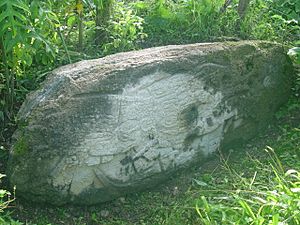Zapote Bobal facts for kids
Zapote Bobal is the modern name for an ancient Maya city. It is an archaeological site located in the Petén region of Guatemala, south of the San Pedro Martir river. The name Zapote Bobal was given by archaeologist Ian Graham, who found the site in the 1970s. It comes from the many Zapote Bobo trees (a type of tree called Pachira aquatica) that grow there, especially near water.
For a long time, Zapote Bobal was not well known in the world of archaeology. But in 2003, a scholar named David Stuart found a link. He realized that Zapote Bobal was the real place mentioned in old Maya writings from other cities like Piedras Negras and Yaxchilan. This ancient name was Hix Witz, which means "Jaguar Hill." Because of this discovery, an archaeological project called Proyecto Peten Noroccidente (PNO) started at Zapote Bobal in 2003. Today, James Fitzsimmons and Laura Gamez lead this project.
Contents
Exploring Zapote Bobal: Buildings and Design
The center of Zapote Bobal was built on top of a flat natural hill. This hill is about 1 kilometer long and 700 meters wide. In the city center, you can find a royal palace, several temple-pyramids, and homes for important people. The site is also famous for its many stone carvings, called monuments, which honor the ancient Maya kings. Outside the main center, there are other groups of mounds, including a pyramid that stands 35 meters tall.
How Long Did People Live Here?
Even though the buildings at Zapote Bobal are very large, like those in a city that was lived in for a long time, it seems the main city center was used for only a short period. The royal family who ruled Zapote Bobal was powerful for about 200 years. Their rule ended around A.D. 800. This is different from most other ancient Maya cities from the Classic Period (A.D. 200-900). Most of those cities had been lived in for much longer before the general collapse of the Maya civilization in the 9th century.
Building a New City Center
Recent discoveries show that the areas around Zapote Bobal were busy with people even before the city center became important. Over 400 buildings have been found within 2.5 kilometers of the city center. This suggests that a new city center was built on top of an older community. The quick building of the main city raises questions about why and how it was created so fast. The fact that the area was already settled makes experts think about big changes or problems in other Maya cities during that time.
Connections with Other Maya Cities
For most of the Late Classic period (AD 600-900), Zapote Bobal was the main city of a kingdom. This kingdom included other sites like Pajaral and probably La Joyanca. A series of kings ruled Zapote Bobal. Most of them had names that included "Chan Ahk," which means "Sky/Serpent Turtle."
Kings and Their Titles
Most Late Classic Maya kings used the title k'uhul ajaw, meaning "holy lord." This title showed that they were seen as very important and almost god-like. However, the kings of Zapote Bobal only used the title ajaw, which simply means "lord." It is not clear why they did not use the "holy" part of the title. Perhaps, as a newer city facing pressure from older, more powerful neighbors, the lords of Zapote Bobal did not have the power or respect to claim the "holy" title on their stone monuments.
Friends and Rivals
Zapote Bobal had links to several major cities in the ancient Maya world. Some of these relationships are clear, while others are still a mystery. For example, writings from cities like Piedras Negras and Yaxchilan mention capturing, killing, or even marrying important people from Zapote Bobal.
But not all connections were negative. King B'alaj Chan K'awiil from Dos Pilas, a big city in another river area, seems to have found a safe place in Zapote Bobal for a short time in the 8th century. He might have even helped build some of the monuments there. This is because the dates of his arrival match when the largest building projects at Zapote Bobal happened. However, the biggest influence on this new kingdom might have come from its northern neighbor, El Perú. Some research suggests a strong link between these two ancient Maya cities.
What's Next for Zapote Bobal?
The story of Zapote Bobal, told through Maya hieroglyphs and archaeology, shows it was a "crossroads" city. It often had to deal with, and probably defend itself from, several more powerful kingdoms. This constant pressure likely played a part in why its royal family rose and fell so quickly. Ongoing archaeological work at Zapote Bobal, along with understanding its ancient writings, will surely help us learn more about these interesting questions.
See also
 In Spanish: Zapote Bobal para niños
In Spanish: Zapote Bobal para niños


